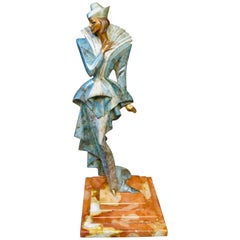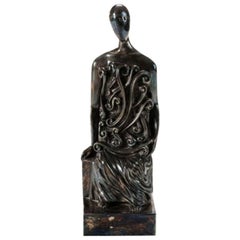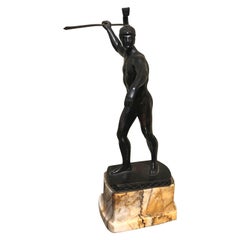Metal Figurative Sculptures
Color: Gold
Material: Metal
Erte Like Fashionable Woman Austrian Bronze
By G. None
Located in Bronx, NY
This beautifully rendered Austrian cold painted bronze is signed (illedgible) & dated. An elegant Art Deco inspired statuesque young woman, fashionably attired in a stunning original...
Category
1990s Austrian Art Deco Metal Figurative Sculptures
Materials
Marble, Bronze
Cast Bronze by Ursula Hanke Forester Foundry N. Nook Berlin
Located in Dallas, TX
Cast Bronze sculpture decor by Ursula Hanke Forester Foundry N. Nook Berlin
One of a kind piece sourced by our accessories buyer.
In my organic, contemporary, vintage and mid-centu...
Category
1950s German Brutalist Vintage Metal Figurative Sculptures
Materials
Bronze
Important Art Nouveau Bronze Sculpture Tambourine Dancer by, Agathon Leonard
Located in Englewood, NJ
An Important French Art Nouveau cast gilt bronze figural sculpture by Agathon Le´onard, "Dansseuse Tambourine á Droité" (Tambourine Dancer to the Right" featuring a woman dancing and...
Category
Early 20th Century French Art Nouveau Metal Figurative Sculptures
Materials
Bronze
Antique French Bronze Art Nouveau Nude Sculpture
Located in Lambertville, NJ
An Artist-signed Art Nouveau nude figure Artist-signed A. Croisy on the base.
Aristide Croisy (31 March 1840-7 November 1899) was a French sculptor. H...
Category
Late 19th Century French Art Nouveau Antique Metal Figurative Sculptures
Materials
Bronze
Giorgio de Chirico, "L'Archeologo, " Bronze Sculpture, Italy, 1971
Located in New York, NY
Edition 17 of 100. Cast at the Fonderia Artistica Cavallari, Rome.
Signed: G. de Chirico
Category
20th Century Italian Metal Figurative Sculptures
Materials
Bronze
19th Century Grand Tour Bronze and Marble Roman Soldier
Located in Charleston, SC
19th century grand tour bronze and marble roman soldier. Great quality and detail.
Category
19th Century Italian Antique Metal Figurative Sculptures
Materials
Marble, Bronze
Giorgio De Chirico, "La Musa" Figural Sculpture, Italy, 1974
Located in New York, NY
Edition 1 of 50. Cast at the Foderia Artistica Cavallari, Rome.
Signed: G. de Chirico
Inscribed: La Musa.
Category
20th Century Italian Metal Figurative Sculptures
Materials
Bronze
Robert Aitken, A Dance, American Art Deco Patinated Bronze Sculpture circa 1920s
By Robert Aitken
Located in New York, NY
Signed ‘AITKEN’, and ‘XOROS’ (Greek: Dance) on the plinth.
Dimensions:
Height 20 inches
Width (top) 11 inches
Depth 6 inches
This remarkable in its expensiveness sculpture depicts a forest spirit – satyr, dancing and playing his reed simultaneously. With horns and horse ears, satyrs were endowed with the qualities of wild creatures with animal qualities, little thought of human prohibitions and moral standards. In addition, they were distinguished by fantastic endurance, both in battle and at the festive table. Their great passion was the passion for music, reed being one of satyrs’ main attributes.
Robert Ingersoll Aitken (1878-1949) was a noted American sculptor, born in San Francisco, California. He became a noted sculptor who spent most of his career teaching at the National Academy of Design in New York City. He has done numerous portraits, full size and bust, of well known figures, and his work is in many collections and museums including the Smithsonian Institution and the Museum of Fine Arts in Boston. For his early study, he was a painting pupil of Arthur Mathews...
Category
1920s American Art Deco Vintage Metal Figurative Sculptures
Materials
Bronze
Pair of Antique French Bronze Appliqués Depicting Art and Music
Located in West Palm Beach, FL
Pair of antique French bronze appliqués depicting art and music, each one finely cast draped putto one holding an artists palette the other a lute.
Art measures: 10.5" H x 6" W
Mus...
Category
19th Century French Baroque Revival Antique Metal Figurative Sculptures
Materials
Bronze
Tibetan Gilt Bronze Figure of Shantideva, 16th-17th Century, Tibet
Located in Austin, TX
A fine and well cast 16th-17th century Tibetan gilt copper alloy statue of Shantideva, the great 8th century Indian teacher and scholar.
The gilt bronze figure expertly cast, with wonderful detail and rich gilding. The face cold painted gold with polychrome details.
Shantideva sits upon a double lotus pedestal, a Vajra before him, an overflowing kapala skull cup...
Category
16th Century Tibetan Ming Antique Metal Figurative Sculptures
Materials
Bronze
Gilt Bronze Soldier Sculpture by Medwedsky
Located in Chicago, IL
Gilt bronze soldier sculpture by Medwedsky, also referred to as bronze-doré. There are no visible prior repairs and the gilding is on very nice all ...
Category
1940s European Vintage Metal Figurative Sculptures
Materials
Bronze
A Highly Unique Anthropomorphic Bronze Vide Poche, Probably Austria Circa 1900
Located in Ottawa, Ontario
A very intriguing and highly unusual bronze vide-poche, sculpted in the form of an anthropomorphic figure cradling a pair of dished recesses.
No visible foundry marks or makers mark...
Category
Early 20th Century European Bohemian Metal Figurative Sculptures
Materials
Bronze
Palatial & Rare Napoleon III French Ormolu and Patinated Bronze Clock, Detouche
By C. Detouche
Located in New York, NY
A palatial, extremely rare, and important Napoleon III French ormolu and patinated bronze regulateur de parquet clock, by Louis-Constantin Detouche, Paris, circa 1850.
The clock case made form the finest French ormolu, with 2 very large patinated bronze seated putti
The white enamel dial Signed C. DETOUCHE/ PARIS. The clock movement is numbered 7064 and stamped with maker’s stamps C. Detouche RUE st. MARTIN and C. DETOUCHE 158 R. St MARTIN 160, with medaille d’argent stamp, on a serpentine part ebonized mahogany plinth.
At over six feet tall, the present clock is impressive in scale and rare in Detouche’s oeuvre. While other large clocks were produced by the firm, few of this scale are so overtly decorative and usually incorporate greater mechanical complication. For example, a gilt bronze astronomical regulator clock...
Category
19th Century French Napoleon III Antique Metal Figurative Sculptures
Materials
Bronze, Ormolu
'The Rape of the Sabines', Bronze Sculpture after Giambologna
By Giambologna
Located in London, GB
This compelling, small scale bronze sculpture depicts ‘The Rape of the Sabines’, after a monumental work by the Renaissance artist, Giambologna (152...
Category
19th Century French Renaissance Antique Metal Figurative Sculptures
Materials
Marble, Bronze, Ormolu
Giacometti inspired Bronze Statue by German Artist Uta Falter- Baumgarten
Located in Jesteburg, DE
Giacometti inspired bronze by German artist Uta Falter- Baumgarten (*1921)- great visual impact.
Category
Late 20th Century German Modern Metal Figurative Sculptures
Materials
Bronze
Pair of Orientalist Bronzes of Standing Turks, Signed Guillot
Located in West Palm Beach, FL
Pair of orientalist bronzes of standing Turks, signed Guillot,
Anatole-Jean-Thomas Guillot French (1865-1911)
Each one intricately dressed holding weapons, raised on Belgian black ...
Category
Late 19th Century French High Victorian Antique Metal Figurative Sculptures
Materials
Belgian Black Marble, Bronze
"David with His Hound, " Unique and Important Sculpture by Paul Manship, 1914
By Paul Manship
Located in Philadelphia, PA
A dignified and poignant bronze by America's greatest sculptor of the 1910s, 1920s and 1930s, this unique piece by Paul Manship depicts young David in ancient Israel...
Category
1910s American Art Deco Vintage Metal Figurative Sculptures
Materials
Bronze
Art Deco Silvered Bronze Sculpture of Dancing Duo by I. Gallo
Located in Oakland, CA
Ignacio Gallo was born in Valladolid, Spain in the 19th century. He worked from 1910–1935 specialising in statuettes of bathers, dancers, nudes and pagan goddesses. While working in Paris in the mid to late 1920s he created this piece of two women dancing. Unlike a nude sculpture, this gives us a glimpse of the era with the fashionable bobbed hairdo, and the shortened skirt.
The 1920s “Jazz Age” saw a great deal of same sex dancing partners some of it romantic but more often just the popularity of both social dance and “artistic” (think Isadora Duncan) as well as “cabaret” performance. This lively sculpture is a nod to all three forms.
Ignacio Gallo’s creations in bronze were made at the Marcel Guillemard Foundry which has an interesting history of its own. Guillemard worked first with Andre Fau...
Category
1930s French Art Deco Vintage Metal Figurative Sculptures
Materials
Bronze
”Child Portrait” Marble and Bronze, Spain, 19th Century
Located in Madrid, ES
"Girl with flowers on a basket". Sculpture in white marble and bronze, on base, Spain, 19th century.
The pedestal, in the shape of a column with a smooth shaft, elevates the sculpture and highlights it with its elegance of lines and lack of exaggerated decorative elements (aside from some moldings in what would be the capital and the marbled marble change in the upper piece, on which the sculpture is located). The figure of the girl, carved in a white marble of great quality, is sitting, looking towards the distance, and with a bouquet of flowers in her arms and a medal hanging from a cord around her neck. When sitting on a basket with flowers the figure is softened, in addition to enhancing it with the chromatic contrast existing between the flowers and the basket (patinated bronze) and the figure. The hair of the girl, with a pictorial waves without a powerful chiaroscuro, contrasts with the detail of the dress, perfect both in the ruffles of the neck and in the embroidery of the fabric and with which, in addition, an "informal" touch has been added to show fallen a strait and the skirt wrinkled. This lack of formality fits perfectly with the theme, and is slightly accentuated by presenting the figure with socks (or stockings, dropped) and without shoes. The realism of the face (attenuated with a slight idealization) suggests that it is a child portrait.
The pictorial treatment of the figure and the roses relate it to artistic approaches that emerged during the 19th century and with a certain aesthetic and skill level. Stylistically, it is possible to relate it to the environment and the influence of two key figures of 19th-century Spanish art for their invoice, traits, technical mastery and originality: Agustín Querol...
Category
19th Century Spanish Neoclassical Antique Metal Figurative Sculptures
Materials
Marble, Bronze
Art Deco Bronze Dancer Bronze, after Bruno Zach
By Bruno Zach
Located in West Palm Beach, FL
Art Deco bronze dancer bronze, after Bruno Zach
Incised B. Zach, A7255.
20th Century, Europe
Dimensions: Height: 26.5 in Width: 13 in Depth: 7 in
Transport yourself back to the 20th...
Category
20th Century European Art Deco Metal Figurative Sculptures
Materials
Marble, Bronze
Goldscheider French Art Deco Bronze Sculpture of a Nude Male Ballet Dancer
Located in Philadelphia, PA
A rare and fine period French Art Deco bronze sculpture of a male dancer or ballerina (nude but for a dancer's belt). The dancer stands with outstretched arms and leg bearing a strai...
Category
1930s French Art Deco Vintage Metal Figurative Sculptures
Materials
Bronze
Art Deco Bronze Sculpture of Kneeling Nude in the style of Arno Breker, 1930
By Arno Breker
Located in Antwerp, BE
Elegant Art Deco bronze sculpture of a naked woman sitting on her knees with her arms over her head. This unsigned figurine is in the style of Arno Breker,...
Category
Mid-20th Century German Art Deco Metal Figurative Sculptures
Materials
Bronze
Maxime Adam-Tessier Figural Bronze Sculpture
Located in New York, NY
Rare and important figural bronze abstract sculpture, Claire, by Maxime Adam-Tessier (1920-2000) circa 1960s. Her unique bust is atypical of his work. Signed with a monogram and mark...
Category
1960s French Vintage Metal Figurative Sculptures
Materials
Bronze
Leo Lionni Original No. 1 of 6 Sculpture the "Giraluna" from Parallel Botany
By Leo Lionni
Located in Middlesex, NJ
The giraluna is a spectral plant entity from Leo Lionni's Classic alternate universe textbook Parallel Botany.
About the Sculpture:
The Giraluna
This elusive and capricious plant is the Dream Queen of parallel botany. Hydendorp, quite rightly, does not hesitate to define it as the "most parallel of plants, most plantlike of the parallels," and in so doing he stresses not so much its physiognomic oddnesses as the disconcerting normality of its shape. "If we were in the jungle," he writes, "and we found one blocking our way, we would not for an instant hesitate to hack it down with our machetes."1
But it will not be our good fortune to encounter it. If in reconstructions the Giraluna displays considerable plantness of form and an exact and convincing solidity, in its natural environment it can be perceived only as a nebulous interplay of glimmerings and empty spaces which alternate in the darkness and vaguely suggest where its outlines might be. (pl. XXIV) Its nocturnal presence, in fact, is manifested almost entirely in terms of the equivocal O'-factor of the moonbeams, which was discovered and measured a few years ago by Dennis Dobkin of the Point Paradise Observatory. This factor changes the light-shade ratio which normally defines volumes into a subtle interplay of lucencies and opacities, so that our perceptions, our basic sensorial habits conditioned by thousands of years of daytime life in the "solar key," would need complete readjustment and indeed reversal in order to come to terms with it. Daylight isolates objects, bestowing a noisy Meaning on all the odds and ends in the world. But night takes everything away except the very soul of things: a black light, a transparent darkness, a secret we cannot grasp.
During the long night of the Erocene era man caught a glimpse of the Giraluna rising mysteriously in its barren landscape. Presolar man imagined himself the child of the Moon. In her lap he had known the comfort of the life, silent torpor of the night, and by her light he had seen silver pearls lie weightlessly upon the coronas of the first great flowers. But he left us only a few enigmatic signs of all this: the Feisenburg cave, the petrified bones in the Ahmenstadt tumulus, the Boergen Cup. Paradoxically enough, all that we do in fact know of his presence in that landscape comes to us from our study of his nocturnal vegetation,
Around the middle of the Erocene era, when the flowers of night were fading away in the light of a new dawn, man saw that outlines and colors were slowly hardening. Thus he discovered the stone-hard world of day, and learned to be the child of both Sun and Moon, of Amnes and Ra, of Disarm and Karak, of Nemsa and Taor. The "crawling stones" of Yorkshire, the stele of Tapur, the graffiti of Klagenstadt, these have preserved for us the nearly obliterated images of the two divinities who from the center of their temples drew the design of the universe.
But the Sun was not long in attaining absolute power over everything in the world. "O Ra, o Amno Ra our benefactor, glowing and flaming! Gods and men bow down before you, for you are their creator and their only Lord." Such was the prayer of Amresh, High Priest of Egypt. And a new vegetation, outspoken and exuberant, appeared on the earth, and made the bright leaves dance in the morning breeze. Night soon became no more than a dark corridor joining one day to another, a place of visions and memories, a storehouse of words and images. It became a secret refuge where the vanished flowers could once more flaunt their coronas to the Moon. And thousands of years later the black flowers of that distant night-Giraluna, Lunaspora, Solea argentea-were born from seeds hidden deep in a soil rich with legends and stories.
If our knowledge of the Giraluna is today reasonably complete and detailed this is due to the industry and scholarship of Professor Johannes Hydendorp of the University of Honingen, who has collected and collated all known facts and kept his records abreast of the latest developments. Our historical and geographical information comes from the most varied sources: legends and folk tales handed down from generation to generation, accounts given by explorers, anthropologists, and paleontologists, and of course the more recent testimony of botanists such as Heinz Hornemann and Pierre Maessens.
Source: Sivatherium. narod .edu
About Sculpture:
Leo Lionni is best known today for his children's books: Little Blue and Little Yellow; Frederick—the one about the mouse who gathers poems while his family is harvesting seeds for the winter—Swimmy the Fish. Of course the children don't remember his name, but to parents and grandparents, the ones who actually do the reading, he is something of a celebrity. Most people don't realize that Lionni is also one of the 20th-century's most influential graphic designers. Within that field, he is a legend. In fact, he didn't start doing children's books until he had left the world of advertising, teaching, and design to allow more time for contemplation and for art. Little Blue and Little Yellow (1959) began as an improvised entertainment for bored grandchildren. What can you do with a few scraps of colored paper and a lot of imagination ? Make the first best-selling children's book illustrated with abstract art. Before that his work as design director for Olivetti Corporation of America and the art director of Fortune magazine, the co-founder of the Aspen...
Category
20th Century American Mid-Century Modern Metal Figurative Sculptures
Materials
Bronze, Steel
Recently Viewed
View AllMore Ways To Browse
Tole Sculpture
Antique Bird Statue
Antique Bronze Coins
Male Terracotta
Wood Signed Sculpture Figural Mid Century
Antique Bird Statues
Ormolu Bronze Statue
Nude Women Sculpture Bronze
Bronze African Head
Bronze Female Statue France
Carved Marble Torso
Hermes God Of
Glass Sculpture Plaque
Pair Of Wood Angel Sculptures
Polychrome Cherub
Marble Sevres
Sea Serpent
Brass Antique Statues





